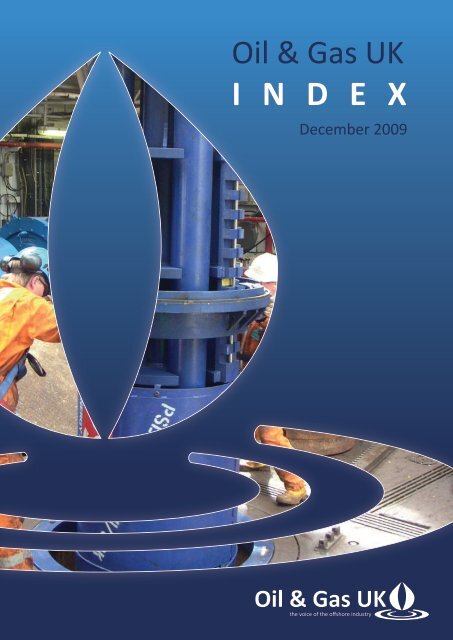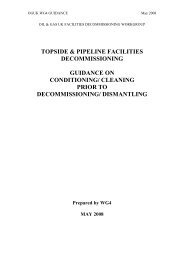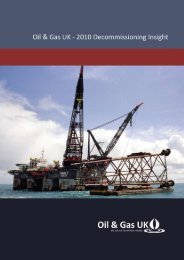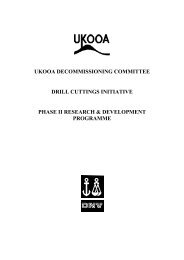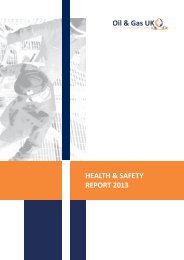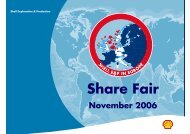THE OIL & GAS UK INDEX
THE OIL & GAS UK INDEX
THE OIL & GAS UK INDEX
Create successful ePaper yourself
Turn your PDF publications into a flip-book with our unique Google optimized e-Paper software.
Oil & Gas <strong>UK</strong><br />
I N D E X<br />
December 2009
<strong>THE</strong> <strong>OIL</strong> & <strong>GAS</strong> <strong>UK</strong> <strong>INDEX</strong><br />
1 Summary<br />
The Oil & Gas <strong>UK</strong> Index<br />
The Oil & Gas <strong>UK</strong> Index is a new quarterly index which measures changes in activity and business<br />
confidence across the <strong>UK</strong> offshore oil and gas industry. It canvasses the views of 1750 companies<br />
in oil and gas exploration and production as well as those providing services and equipment in the<br />
supply chain.<br />
Nine economic indicators are used to compile sub‐indices, covering investment, revenues/ sales,<br />
operation/ running costs, manpower and day rates, expenditure in research and development,<br />
employment and training as well as general business confidence and activity. These indices are<br />
aggregated to provide an overall measure of industry confidence, with a higher rating indicating a<br />
positive outlook and a lower rating giving a more negative standpoint (the index is on a 100 point<br />
scale with 50 being neutral).<br />
Oil & Gas <strong>UK</strong> carried out its surveys at the end of each of the first three quarters in 2009 and the<br />
results are now considered sufficiently mature to launch the index externally. The surveys will<br />
continue to be published on a quarterly basis and over time it is hoped the index will become a<br />
useful forecasting tool for the sector.<br />
Conclusions<br />
• The Oil & Gas <strong>UK</strong> Index for Q3 2009 measured 50; up four points from Q1 2009. This indicates<br />
a marginal improvement in business confidence across the year as the oil price lifted from $33<br />
per barrel in January to the current price of around $70 per barrel and as access to financial<br />
markets eased.<br />
• However, the overall ranking of 50 points at the end of Q3 suggests that business confidence in<br />
the upstream sector is still to recover to that seen some two to three years ago. Despite<br />
higher oil prices, wholesale gas prices are still depressed and coupled with continued<br />
uncertainty about the pace of economic recovery, the industry remains cautious in its overall<br />
business outlook.<br />
• On average, confidence amongst exploration and production (E&P) companies appears to be<br />
more positive than businesses in the supply chain. Confidence in the E&P sector gained 10<br />
basis points across the year to reach 63 in Q3 2009, while across the supply chain it rose from<br />
41 to 47. Within the E&P sector, it would seem that the independent production companies<br />
are more optimistic than the major, integrated companies, with the former reporting more<br />
positive outlooks on overall business confidence, investment, activity growth and business<br />
revenues.<br />
• These first signs of revival in the business confidence felt by E&P companies are yet to work<br />
their way through to the offshore oil and gas supply chain which is still largely experiencing<br />
weak or even declining activity. There is uncertainty on the investment outlook which Oil &<br />
Gas <strong>UK</strong> observes may yet improve as we go into 2010 but this will depend on a range of factors<br />
including broader movement of costs, outlook for commodity prices and the general business<br />
environment.<br />
‐ 1 ‐
• The drilling and well services and marine and subsea services sectors appear to have been hit<br />
hardest by the prevailing economic climate. Business confidence in these segments of the<br />
industry was on average 11 basis points below the industry average throughout the year. By<br />
Q3, the drilling and well services index was 12 points below the index average and the marine<br />
and subsea index was 13 points below.<br />
• On employment, it would appear that many supply chain companies are still feeling the impact<br />
of reduced activity and postponement of investment. However, we believe the whole industry<br />
is intent on retaining its skilled workforce and is apparently only resorting to job cuts where no<br />
other solution is possible.<br />
• Overall, the pressure to reduce costs and raise competitiveness is still working its way through<br />
the province. E&P companies acted early in response to the changes in the oil price and are<br />
now gaining confidence on the delivery of the programmes put in place. Drilling and well<br />
services, marine and subsea services are still working to drive their costs down in their<br />
businesses to restore competitiveness.<br />
2 Introduction<br />
In these challenged economic times it is important that the <strong>UK</strong> focuses on the health of the key<br />
sectors of its economy which can act as a barometer for recovery. To aide this, Oil & Gas <strong>UK</strong>, the<br />
representative organisation for the <strong>UK</strong> offshore oil and gas industry, has developed a quarterly<br />
index to gain a better insight into the health of the offshore oil and gas sector and to track how<br />
each of its diverse segments of activity is performing.<br />
The Oil & Gas <strong>UK</strong> Index is compiled from the results of surveys which are distributed to 1750<br />
companies across the <strong>UK</strong> at the end of each quarter. The response rate was good with 350<br />
companies replying which represents close to 40% of the annual turnover of the entire sector.<br />
Respondents are asked to comment on their anticipated activity in each of nine economic<br />
indicators: investment, revenues/ sales, operation/ running costs, manpower and day rates,<br />
expenditure in research and development, employment and training and to provide feedback on<br />
general business confidence and activity levels.<br />
These indices are aggregated to provide an overall measure of industry confidence, with higher<br />
index rankings (above 50, which is neutral on the 100 point scale) indicating a positive outlook and<br />
lower rankings (below 50) giving a more negative standpoint.<br />
2.1 Industry Overview and Segmentation<br />
For the purposes of the Oil & Gas <strong>UK</strong> Index, the <strong>UK</strong>’s upstream oil and gas industry has been<br />
segmented into its various constituent parts:<br />
Exploration and production (E&P) companies, split by size:‐<br />
(i) Majors (large, integrated oil and gas companies)<br />
(ii) Independents (large, medium and small E&P companies, utilities, and exploration<br />
companies)<br />
‐ 2 ‐
Oil and gas supply chain split by business segment, focusing in on the following:‐<br />
(i) Drilling and well services – refers to the drilling operation and completions. It employs<br />
personnel in the design of the drilling campaigns and on offshore rigs undertaking the<br />
drilling, evaluation and completion processes.<br />
(ii) Facilities engineering, operations and maintenance – relates to platforms/topside design,<br />
fabrication, construction, maintenance and operations, plant design and manufacture.<br />
(iii) Marine and subsea – this sector includes floating production facilities, SURF (Subsea<br />
Production Systems, Umbilicals, Riser, Flow lines) together with pipeline and marine<br />
contractors.<br />
(iv) General support services – this sector covers a wide range of companies including logistic<br />
and transportation, the supply of HSE equipment and consultancy, training across all areas<br />
of the oil and gas industry, specialist finance, insurance and legal and catering services.<br />
2.2 Survey Questions<br />
The Oil & Gas <strong>UK</strong> Index is created from the results of a survey which is sent out to senior supply<br />
chain managers or senior purchasing personnel in 1750 companies across the <strong>UK</strong>. These<br />
companies represent all the segments of the <strong>UK</strong> upstream oil and gas business, as defined in<br />
Section 2.1.<br />
Respondents are asked to answer nine key questions focusing on their <strong>UK</strong> business and consider<br />
for each question whether their expectations will be lower, the same or higher in the following<br />
quarter compared to the current quarter.<br />
The nine questions address:‐<br />
(i) Business confidence and optimism<br />
(ii) Business activity and levels (volume of work)<br />
(iii) Business revenue/sales<br />
(iv) Investment<br />
(v) Operating and running costs<br />
(vi) Manpower and day rates<br />
(vii) R&D spend<br />
(viii) Employment<br />
(ix) Training<br />
2.3 Ranking Methodology<br />
Each question is ranked 1‐3. The rank given to the question depends on the influence it is<br />
considered to have on business growth and confidence. The response to the question, whether it<br />
is a negative, neutral or positive outlook for the next quarter is then rated 0, 1, or 2.<br />
Firstly, an index for each survey response is calculated. This is done by multiplying the rank for<br />
each question by the rating for the response given. Then all nine calculations (one for each<br />
question) are added up. Finally, to give a value between 0 and 100, the sum is multiplied by a<br />
constant.<br />
‐ 3 ‐
To calculate the overall indices, the companies that have responded are given a ranking of 1‐5<br />
depending on company turnover. The company index is then multiplied by the company rank. The<br />
sum of these calculations is then divided by the sum of the company ranks. The indices are<br />
therefore weighted averages.<br />
3 Business Environment<br />
The global recession coupled with the freeze in financial markets as the banking crisis deepened in<br />
2008 and early 2009 dealt the <strong>UK</strong> offshore oil and gas industry a double blow. Oil prices fell<br />
dramatically in the latter half of 2008 from almost $150 barrels of oil equivalent (boe) to just over<br />
$30boe (figure 1), while access to debt and equity financing on reasonable terms dried up.<br />
Exploration activity on the <strong>UK</strong> continental shelf dropped 57 per cent in January to September<br />
2009, compared with the same period in 2008. Development projects were put on hold as E&P<br />
companies reappraised their business models and looked for cost savings in light of the lower<br />
commodity prices and increasing competition for investment funds from overseas. The<br />
Government introduced a field allowance in its April 2009 Budget, targeting a limited number of<br />
new field developments (small fields, heavy oil and high pressure high temperature (HPHT)<br />
projects). While this was a step in the right direction, its impact on new investment was minimal.<br />
Brent Spot Price ($/bbl)<br />
160<br />
140<br />
120<br />
100<br />
80<br />
60<br />
40<br />
20<br />
0<br />
Brent Oil Price vs <strong>UK</strong> Gas Price<br />
Brent Oil<br />
<strong>UK</strong> Gas<br />
160<br />
140<br />
120<br />
100<br />
80<br />
60<br />
40<br />
20<br />
0<br />
Day Ahead NBP Gas Price ($/boe)<br />
4 Oil & Gas <strong>UK</strong> Index Indicators<br />
Figure 1:‐ Daily Brent Oil Price and Daily <strong>UK</strong> Gas Price 2008‐2009<br />
The following section provides an overview of the index and responses by quarter and industry<br />
segmentation.<br />
Oil & Gas <strong>UK</strong> Index<br />
Quarter E&P Companies Supply Chain Industry<br />
Companies<br />
Q1 2009 53 41 46<br />
Q2 2009 59 48 49<br />
Q3 2009 63 47 50<br />
Figure 2:‐ Oil & Gas <strong>UK</strong> Index<br />
‐ 4 ‐
Industry E&P Supply Chain Companies<br />
70<br />
60<br />
Index<br />
50<br />
40<br />
30<br />
20<br />
Q1 Q2 Q3<br />
Figure 3:‐ Oil & Gas <strong>UK</strong> index over the three quarters<br />
Oil & Gas <strong>UK</strong> Index by Segment Q1 Q2 Q3<br />
E&P Companies<br />
Majors 48 56 57<br />
Independents 57 61 67<br />
Supply Chain Companies<br />
Drilling & Well Services 35 45 38<br />
Facilities Engineering, Operations &<br />
Maintenance<br />
44 49 50<br />
Marine & Subsea 30 42 37<br />
Support Services 43 49 49<br />
Figure 4:‐ Oil & Gas <strong>UK</strong> Index by Segment<br />
Majors<br />
Independents<br />
70<br />
60<br />
Index<br />
50<br />
40<br />
30<br />
20<br />
Q1 Q2 Q3<br />
Figure 5:‐ Oil & Gas <strong>UK</strong> E&P Company Index over the three quarters<br />
‐ 5 ‐
Wells Marine & Subsea Facilities Support Services<br />
70<br />
60<br />
Index<br />
50<br />
40<br />
30<br />
20<br />
Q1 Q2 Q3<br />
Figure 6:‐ Oil & Gas <strong>UK</strong> Supply Chain Company Index over the three quarters<br />
Companies were asked to state whether they felt the business outlook for the next quarter would<br />
be better, worse or the same as the current quarter for a range of economic indicators. Their<br />
responses were used to compile sub‐indices which were then aggregated to provide the overall<br />
measure of industry confidence seen in the above figures. The following table summarises the<br />
general direction of the individual indicator responses, where the plus sign signifies a positive<br />
outlook, a minus sign indicates a negative outlook and the equal sign means no change.<br />
‐ 6 ‐
Swing in sentiment by sector<br />
Indicator 2009 Q1 Q2 Q3<br />
Business<br />
Confidence<br />
Activity Levels<br />
Business Revenue<br />
Investment<br />
Operation and<br />
Running Costs<br />
Manpower and<br />
Day Rates<br />
R&D Spend<br />
Employment<br />
Spend on<br />
Training<br />
Overall - ≈ +<br />
E&P - + +<br />
SC - - ≈<br />
Overall - ≈ ≈<br />
E&P - + +<br />
SC - - -<br />
Overall - ≈ ≈<br />
E&P - + +<br />
SC - - -<br />
Overall - - -<br />
E&P + - +<br />
SC - - -<br />
Overall - - -<br />
E&P - - -<br />
SC - - -<br />
Overall - - -<br />
E&P - - -<br />
SC - - -<br />
Overall - - -<br />
E&P - - +<br />
SC - - -<br />
Overall - - ≈<br />
E&P - ≈ +<br />
SC - - -<br />
Overall - - -<br />
E&P - - +<br />
SC - - -<br />
key: - Lower<br />
≈ Neutral<br />
+ Higher<br />
E&P E&P Companies<br />
SC Supply Chain<br />
Figure 7:‐ Swing in sentiment by sector<br />
‐ 7 ‐


